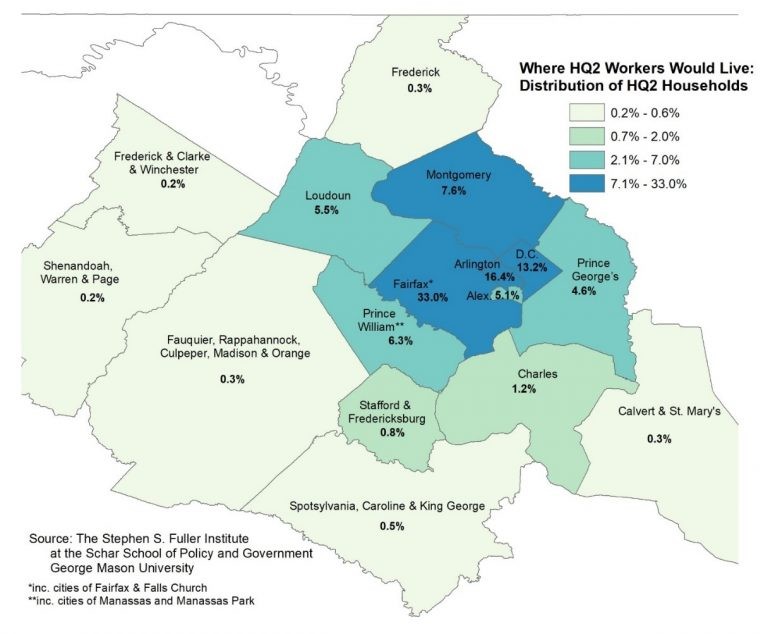They did the math: Amazon will barely impact our already supercharged housing market
_800_577_90.jpg)
H Street NW in the Mount Vernon Triangle neighborhood of DC by NCinDC licensed under Creative Commons.
Researchers have found that the influx of Amazon employees will not significantly affect the housing supply, though the region’s housing costs will likely remain some of the most expensive in the country. That's a key finding from George Mason University’s Fuller Institute, which published a study that looks at the impact of Amazon’s HQ2 on the Washington region’s housing.
“Overall, HQ2 would increase the demand for housing in the Washington region. However, this demand would be relatively dispersed in the region and occur gradually, allowing jurisdictions to plan for the increase or adjust their current plans as needed,” the study says, also pointing out that Amazon-specific increases in housing prices would be difficult to isolate.
This study was based on the scenario of the area receiving the full second headquarters, which would add about 50,000 jobs and 200,000 new residents to the region. These estimates include both people who are directly employed by Amazon, as well as new workers employed in “spinoff” jobs.
The study was prepared before Amazon announced that half of the HQ2 is going to New York City, and half will go to National Landing in Arlington and Alexandria, Virginia. Nonetheless, the findings are still informative and most of the numbers are scaleable, says Jeannette Chapman, Deputy Director of the Fuller Institute.
Graph from the Fuller Institute study, based on full HQ2 numbers. 
Amazon’s half-HQ2 will add about 25,000 jobs and 100,000 new residents by 2030, and Virginia could incentivize up to 37,850 jobs by 2034. That's undoubtedly still a lot of new people.
Still, the original estimates (another 50,000 people) only represent a small fraction (6-13%) of the overall growth we have experienced over the last 20 years. Accordingly, rents should continue to rise, but Amazon’s role in the increases will be indiscernible, the study shows.
The report goes on to state that “[a]dditional supply would mitigate any price increases that would occur for the existing housing stock […] If supply constraints continue, prices will likely rise faster than historic norms, although a relatively small share of this rise would be HQ2-specific.”
These new workers would likely spread around the region. As a result of HQ2 and indirect jobs, the Fuller Institute estimates that the largest share of new residents—nearly 25,000 in their estimates, now about half that—will move to Fairfax. Arlington will add 9,000 (now 4,500 by 2030) new households, and Loudoun, Prince William, and DC will each add at least 5,000 households (now 2,500 by 2030) each.
Graph from the Fuller Institute study, based on full HQ2 numbers. 
Beyond the regional disbursement of new residents, several other factors could help ease the existing crunch. The report notes that recent increases in the region’s housing supply have kept rent inflation largely in line with the national average.
Secondly, HQ2’s arrival will coincide with what could be a major shift in the housing market: Baby Boomers downsizing and relocating. If this shift does occur, it could result in more housing being available, thereby reducing demand on the region's supply of homes.
Third, Amazon’s employees will be more likely to rent or buy newly-constructed housing due to their high salaries, rather than competing with residents over the existing lower-cost housing supply.
One final point: housing supply matters. The study says, “While the HQ2 metrics indicate the degree of demand that it could generate, the supply of homes will also play a key role in determining future pricing. New home construction in the Washington region, while improving, continues to lag historic norms. If this pattern continues, housing prices may continue to rise faster than in the past relative to household growth, with or without HQ2. Builders may see HQ2 as an opportunity and increase production as a result.”
Ultimately, even with Amazon's increased presence, our region faces the same existing housing woes—a restricted supply of units that need to accommodate a growing population.
